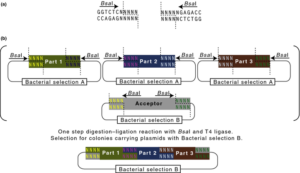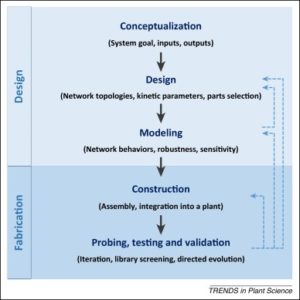Review: Using CRISPR/Cas in three dimensions: towards synthetic plant genomes, transcriptomes and epigenomes
 Puchta reviews the different ways that CRISPR/Cas9 can be used in synthetic biolgy, beyond the common gene-editing function. For example, the Cas9 protein can be fused to other proteins that activate or repress transcription, and targeted to different promoters using guide RNAs. He further explores the possibility of one day producing synthetic plant genomes. Plant J. 10.1111/tpj.13100
Puchta reviews the different ways that CRISPR/Cas9 can be used in synthetic biolgy, beyond the common gene-editing function. For example, the Cas9 protein can be fused to other proteins that activate or repress transcription, and targeted to different promoters using guide RNAs. He further explores the possibility of one day producing synthetic plant genomes. Plant J. 10.1111/tpj.13100


 Control of gene expression involves both activation and repression of transcription. Schaumberg et al. used transient expression in Arabidopsis and sorghum protoplasts and dual-luciferase outputs to rapidly quantitate synthetic repressors and repressible promoters, and verified their results in transgenic Arabidopsis plants. Nature Methods
Control of gene expression involves both activation and repression of transcription. Schaumberg et al. used transient expression in Arabidopsis and sorghum protoplasts and dual-luciferase outputs to rapidly quantitate synthetic repressors and repressible promoters, and verified their results in transgenic Arabidopsis plants. Nature Methods  Patron et al. describe the need to standardize DNA parts and terminology, so that researchers and inventors can use off-the-shelf parts (they draw an analogy to the standardization of components in mechanical and electronic engineering). New Phytol.
Patron et al. describe the need to standardize DNA parts and terminology, so that researchers and inventors can use off-the-shelf parts (they draw an analogy to the standardization of components in mechanical and electronic engineering). New Phytol.  Liu and Stewart provide an overview of the design cycle for plant synthetic biology, driven by engineering principles. They describe components and design tools, and give examples of the application of synthetic biology including the design of biosensors and alterations of plant metabolic pathways. Trends Plant Sci.
Liu and Stewart provide an overview of the design cycle for plant synthetic biology, driven by engineering principles. They describe components and design tools, and give examples of the application of synthetic biology including the design of biosensors and alterations of plant metabolic pathways. Trends Plant Sci.